This post may contain affiliate links. If you click through a link and make a purchase, I may receive a commission at no additional cost to you. As an Amazon Associate, I earn from qualifying purchases. Read the full disclosure here.
You might think that step aerobics went out with colorful leotards and big hair, but this low-impact cardio blast is still very much alive.
Other than the fun factor, what I love about step aerobics is that you don’t have to try that hard to get your heart rate up.
It just happens naturally, and within a few minutes, you can be burning major calories. The best part is, you’re in total control of your intensity.
But wait, isn’t step aerobics complicated?!
If you feel like step class is an exclusive club that you never got the invite to, this article will give you all the tips you need to know to get started, even as a complete beginner!
- What is step aerobics?
- What are the benefits of step aerobics?
- Is step aerobics good for weight loss?
- How many calories does step aerobics burn?
- Is step aerobics bad for knees?
- What muscles does step aerobics work?
- What’s the best shoe for step aerobics?
- Step aerobics for beginners – how to get started
- How can I learn step aerobics moves?
- Where can I find step aerobics workouts?
- Beginner step aerobics classes online
- What size step do I need for step aerobics?
- Wrapping up
Disclaimer: This content is for educational purposes and is not medical advice. Read the full disclaimer.
What is step aerobics?
Step aerobics is a low-impact cardio workout using a step box with moves choreographed to the beat of the music.
Step became highly popular in the 1980s and 1990s with the release of the original Reebok step bench, which you can still buy today.
Chris Nugent, certified step aerobics instructor, says, “Step is my favorite workout because it can be different every time. There is a learning curve, which can take a few classes as you become familiar with step language.”
So let’s help you make that learning curve less intimidating!
What are the benefits of step aerobics?
Step comes with all the benefits of aerobic exercise, including improved heart health, blood pressure, endurance, and a boost for your overall mood.
There’s also a lower body strengthening component for all major muscle groups as you move up, down, and around your step in this high-energy workout.
Choreographed workouts are excellent for your brain as you process different movements and master your mind-body connection. Studies show that engaging in mentally stimulating activity helps to preserve cognitive function and may even help protect against dementia.
If you’re taking step as part of a group fitness class, you also get that community feeling and extra motivation.
Traditional step classes focus only on aerobics. However, step interval classes with breaks to do strength training exercises are also a popular format.
It’s important to note that step workouts can be adapted to any fitness level, so keep reading for plenty of ways to help you enjoy this fun fitness activity.
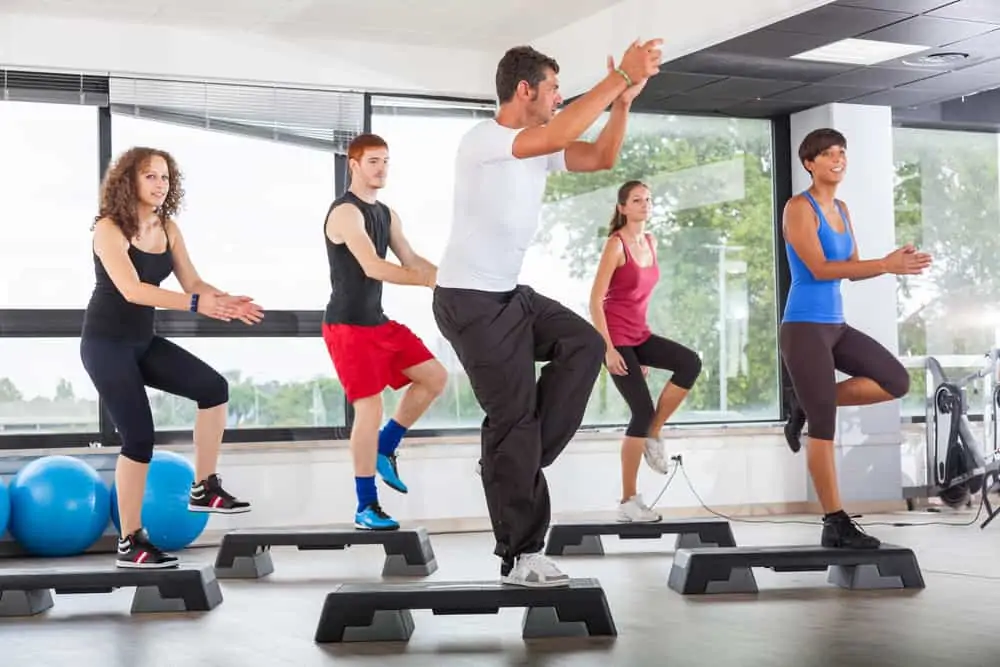
Is step aerobics good for weight loss?
Yes! A healthy mix of cardiovascular exercise combined with strength training is a winning combination.
Step is a great high cardio low impact workout for weight loss and is way more fun than zoning out on a piece of cardio equipment to the latest Netflix binge.
Remember, the best workouts for you will be the ones you enjoy doing. Consistency with a fitness program is the best way to reach your goals.
Step classes are a fun way to keep you motivated and coming back for more.
How many calories does step aerobics burn?
This question is tricky because calorie burn varies significantly from person to person. Height, weight, and most importantly, how much effort you put into your workout will be major factors in how many calories you burn during a workout.
According to the Center for Disease Control and Prevention (CDC), a 154-pound person burns anywhere between 140 and 295 calories in 30 minutes of cardio exercise. As you can see, it’s kind of a wide range.
Your best bet for answering this question will be to wear a fitness tracker or heart rate monitor during your workout.
Don’t forget to read this article diving deep into how fitness trackers work, accuracy concerns, and which ones are the best.
Is step aerobics bad for knees?
A common misconception!
In reality, unless you have severe joint pain or damage to your knees, step aerobics is generally considered a low-impact activity.
There are many ways to modify step aerobics to accommodate sensitive knees. You can always eliminate jumping or excessive twisting to be more joint-friendly.
You can also use no risers (making the step only 4” high) or no step at all and do the movements on the floor.
In general, the higher the step, the more likely it is to bother your knees. (More later on about how to choose the right height for your step bench.)
What muscles does step aerobics work?
Step aerobics is a high cardio exercise for the entire body that works all of the major muscle groups of the lower body, including the glutes, hips, quadriceps, hamstrings, and calves.
Depending on your arm movement, there is also core muscle involvement.
If the class is an interval style with weights, there’s an opportunity for upper body strengthening.
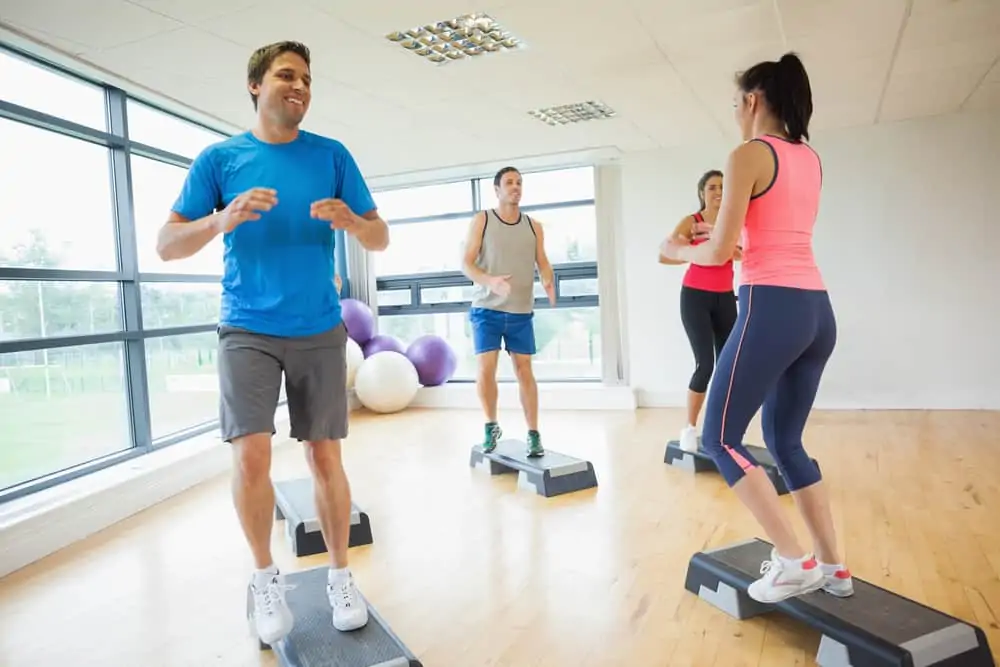
What’s the best shoe for step aerobics?
A critical question!
Running shoes tend to be everyone’s go-to for all-around gym shoes, but for step aerobics, their squishy support and grippy bottom don’t allow you to move as quickly and could trip you up.
The best type of sneaker for step aerobics is a cross-training shoe with good lateral support to make pivoting and directional changes easy. Lateral support helps avoid rolling an ankle!
*Never wear casual shoes or slip-on sneakers for workouts. These shoes lack essential features to keep you safe and can result in injury.*
Here are some examples of popular cross-training shoes to add to your collection:
You can also add over-the-counter insoles to your shoes to customize the fit to better support your shoe.
New Superfeet customers can get 10% off with email sign-up – click here and use code WELCOME10.
Don’t forget to check out which retailers are offering cash back through Rakuten. Use my referral code to earn up to a $30 bonus on your first qualifying purchase just for signing up.
Step aerobics for beginners – how to get started
Here are all the basics plus some crucial safety tips to get you started! After this article, you’ll be able to walk into any step aerobics class with total confidence.
Choose your spot
It can be tempting to hide in the back of the room, but make sure you can clearly see the instructor.
Give your neighbors some space. In step aerobics, you will be moving around, and people do occasionally trip and fall during step class. Ideally, it’s best to have several feet clear in all directions around your step.
Don’t be the person who sets up *right on top* of someone else. If you’re not sure, just ask. Regular steppers can be territorial about their space. It’s better to ask and be warmly welcomed.
If you’re doing step aerobics at home, make sure you clear a perimeter of several feet around your step to avoid injuries.
Adjust the height of your step
Contrary to popular belief, more height doesn’t mean you’re a better stepper. More height actually means you’re more likely to get hurt.
You might see people in a gym using several risers to perform isolated strength exercises – that’s not what we’re doing here.
In step, you’ll be moving around quickly to the beat of the music.
Risers should be based on height. If you have your step set too high, you’ll get tripped up, and it will be challenging to keep up with the tempo of the class.
The basic height of the step bench is typically 4 inches high – no matter what the brand. Each riser adds 2 inches to the total height. Here’s a handy chart!
STEP HEIGHT GUIDE
| Bench only | 4 inches |
| Bench + 1 set of risers | 6 inches |
| Bench + 2 sets of risers | 8 inches |
No step is always an option! It’s perfectly acceptable to follow along on the floor, especially if you’re new or recovering from an injury.
For reference, I’m 5’11,” and I use one riser (for a total of 6”), sometimes no risers (total 4”). It depends on how I’m feeling. (And yes, you can still get an awesome workout without using risers.)
Lock your step
No matter what brand of step, risers will always fit into grooves on the step board.
Make sure the risers are lined up and locked into place to avoid any accidents.
Use anti-slip pads
Step boxes have rubber on the bottom to prevent the step from sliding during exercise. Between age, dust, and cleaning products on the gym floor, step boxes may start to slide over time.
Grab yourself some anti-slip pads to keep your step firmly in place!
Jar gripper pads work well to keep steps in place. You can also buy cabinet liner and cut it into small pieces yourself. You can typically use these pads for several months before they need to be replaced.
Clear your area
During a step workout, you’ll be moving all around your step.
Clear your step area from water bottles, towels, weights, phones, etc. to avoid tripping.
If you’re in a group fitness setting, check your area for spilled water or sweat from a previous class.
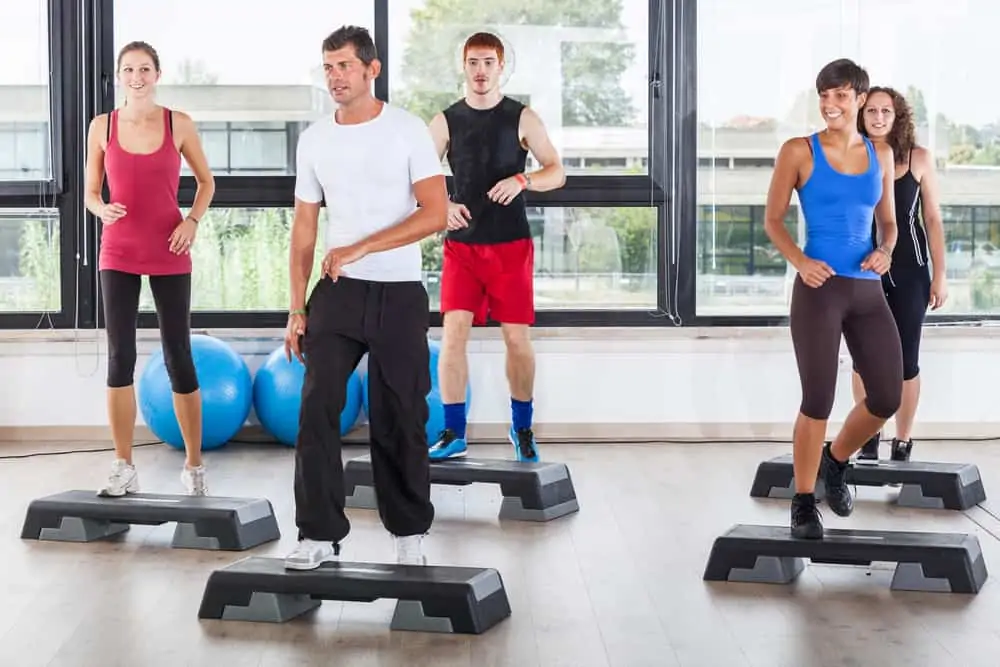
Put your whole foot on the step
Now we’re getting into the meat and potatoes of how to make you a great stepper.
Ensure you always place your whole foot on the step, don’t just place your toe and let the back of your foot off the step platform. (Plenty of people slip off the step or get tripped up because they forgot this tip.)
Also, try not to slam your feet. Even though you’re placing your whole foot on the step, you’re moving quickly through the routine, so more of your weight should be on the forefoot to be ready for whatever comes next. In other words, don’t stand there flat-footed – be ready to move!
Learn basic step aerobics moves
There’s a learning curve to step aerobics, sometimes even between instructors. Learning some basic step exercises for beginners and becoming familiar with cues will accelerate your progress.
Step aerobics is highly choreographed. A big part of success with step aerobics is marking time and staying with the beat to keep up with the pace of the class.
Practice listening to the music and placing your feet to the beat.
If you notice you seem to be a half step behind everyone else, don’t use any risers until you become more comfortable and can keep pace with the beat.
The CDorner Fitness YouTube channel is an amazing resource for aerobic step exercises for beginners. She has an entire playlist dedicated to learning step moves.
This playlist is gold for beginners nervous about learning step aerobics. She has 48 videos breaking down common step moves so you can practice before you get to a class.
Modify step moves to work for you
In a group fitness setting, sometimes people are intimidated to stray from the class by modifying movements (or may not even know which modifications are a good option if they’re not provided).
It’s completely fine to modify any movements to make them work better for you. Examples in step are eliminating jumps, turns, or other fancy footwork.
Even if you stay with “basic step,” you’ll catch up with the class again. As long as you mark the time correctly, you can swap in anything that works for you and still be on pace with the class.
Remember, you’re in total control of the intensity of your workout.
Heart rate feels a little high? March it out.
Just want to watch a sequence before trying? March it out.
Lost your way? March it out.
My point is, just keep moving, and you’ll get there.
Stay hydrated
Did I mention that step is high-cardio?!
Keep a full water bottle and towel near and take breaks to grab a drink.
Some classes don’t cue for water breaks, so it’s up to you to listen to your body. To stay hydrated, be sure to take a few sips at least every 15 minutes.
Taking a short water break is also an easy way to reset if the choreography is becoming overwhelming.
Don’t give up
If you’re new or frustrated by step aerobics, this is what you need to hear.
There is a definite learning curve to step aerobics. It takes at least a few weeks to become familiar with the terminology and choreography, but you’ll quickly notice a lot of improvement.
The most important thing to remember is to keep coming back!
It’s no big deal if you mess up! Even people who have been doing this for years mess up in class, just march it out and rejoin when you’re ready.
Wear your fitness watch
Wear your fitness watch! It’s fun to see the results of your hard work. I think you’ll be surprised at how quickly those calories start to spiral!
I burn about 600 calories in a 60 min step aerobics class. Your calorie burn will be more or less based on individual factors like height/weight and intensity.
The only way to really know is to wear a fitness tracker.
Related read: Are Fitness Trackers Worth It?
How can I learn step aerobics moves?
Not knowing step moves is a major roadblock for beginners, causing them to avoid step aerobics altogether or leave classes feeling frustrated and maybe even a little embarrassed.
What if there was an awesome free resource for you to learn step aerobics moves for beginners?
I mentioned CDorner Fitness on YouTube above, but just in case you were skimming, I’ll say it again.
Check out this entire playlist breaking down all the step moves you need to feel confident to join a step class!
This compilation of quick videos is one of the most comprehensive resources I’ve seen to help beginners.
Where can I find step aerobics workouts?
Step is still very much alive, but it depends on the gym. Check local gym class schedules for step class varieties near you.
Beginner step aerobics classes online
For online options to do step aerobics at home, here are some YouTube Channels to check out.
C Dorner Fitness
C Dorner Fitness has tons of step content for beginner and intermediate levels. She also has some videos at a slower-paced beat per minute, which is great for new steppers.
The Gym Box
The gym box has step workouts from beginner to advanced. They also have other workouts like spinning, kickboxing, and Pilates.
It’s A Step Thang
It’s A Step Thang has beginner and intermediate step workouts. They also demonstrate step moves in halftime to make it easier to nail the choreography.
Step Junkie
Step Junkie has beginner, intermediate, and advanced videos. Many of the combinations are broken down into shorter videos if you want to grab some quick practice!
What size step do I need for step aerobics?
It’s easy to start a step aerobics routine at home. All you need is a step bench and some space!
Step benches come in full and compact sizes, but for step aerobics, you really need the full-size step board to give yourself space to move around.
A full-size step is approximately 43″ x 16.”
The two best step aerobics platforms are The Original Reebok Step and The Original Aerobic Platform.
Both of these options come with risers to adjust the step to your preferred height.
If you’re buying directly from Reebok new customers can get 15% off by clicking here and signing up for email.
Wrapping up
Don’t be intimidated by step aerobics. Sure there’s a learning curve, but if you keep coming back, you can enjoy this calorie-torching workout for years to come.
You might also like:

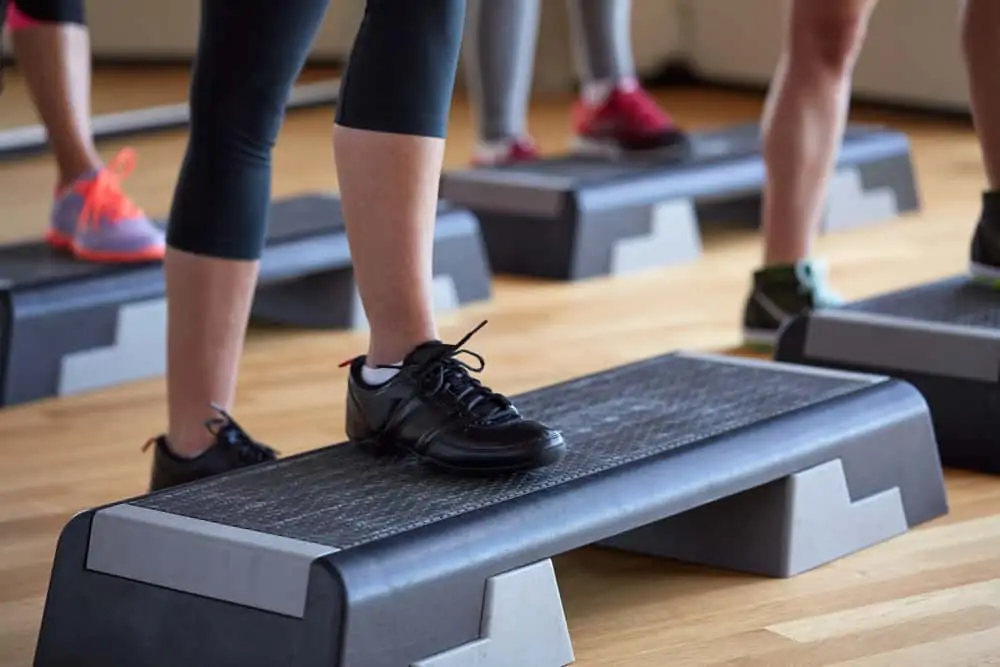

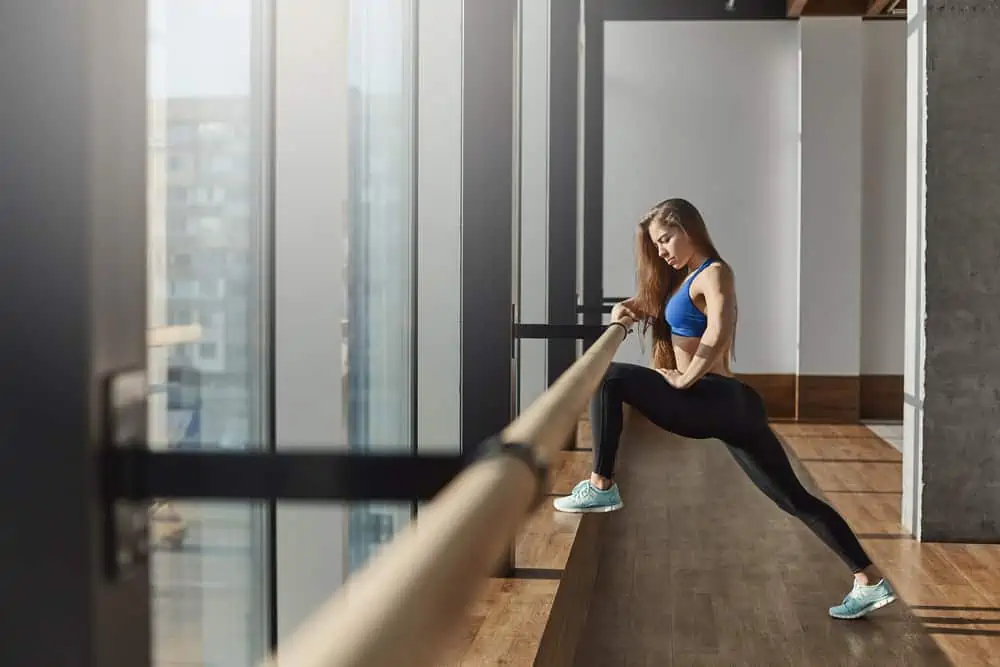

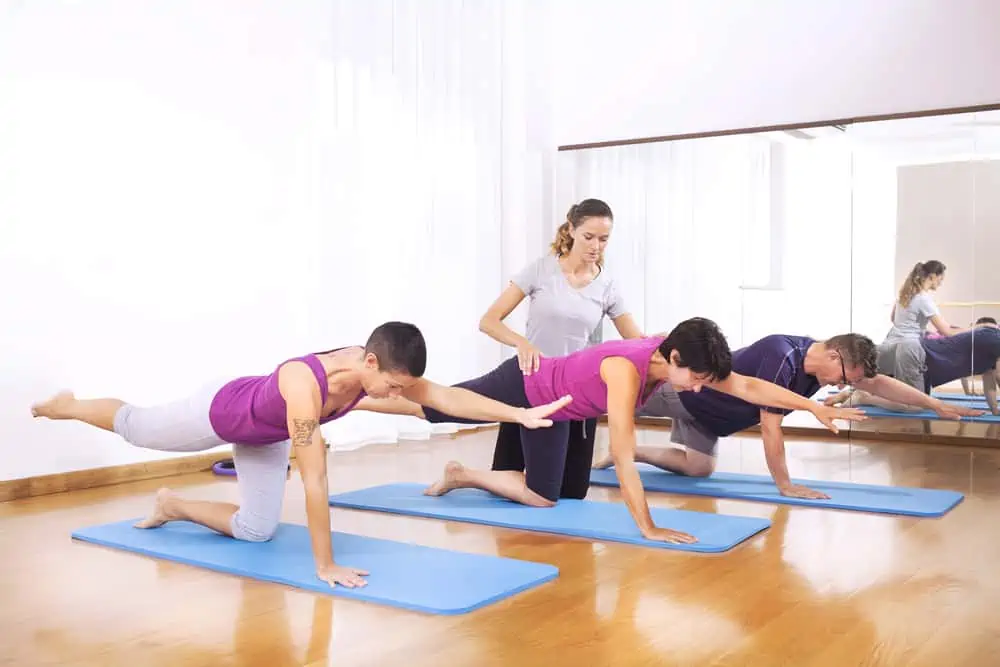

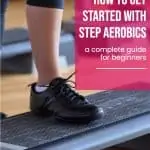
This is such a great post. I really appreciate all the details you included, especially making it clear everyone is at different levels and there are a variety of ways to do the step aerobics. Thank you for sharing. ?
Thanks for reading. My hope is to give the basics and take the overwhelm out of the equation. Hopefully, it will inspire more people to try this fun type of exercise.
You’ve inspired me, step aerobics looks so fun! I’m a dancer, but because of a knee surgery in childhood I’ve been instructed to never run/jog again. I’m always looking for good cardio cross-training options that don’t bother the knee 🙂
Awesome! It’s a great workout to incorporate into your routine. Glad the tips were helpful!
I actually did step aerobics before on Beachbody on Demand. It was okay but my legs kind of felt like jello after
Yes, it can be a really demanding workout.